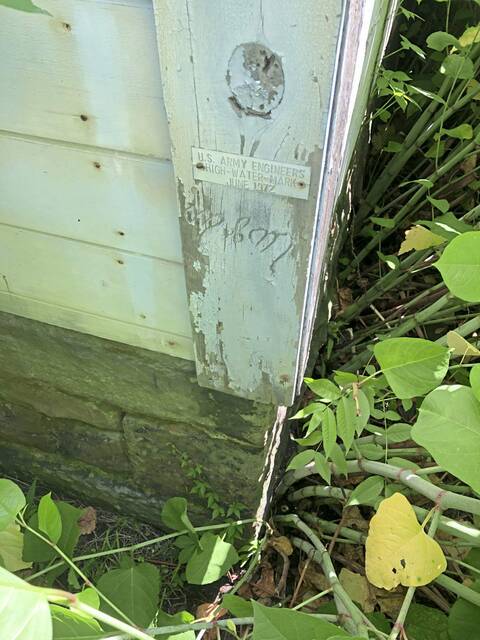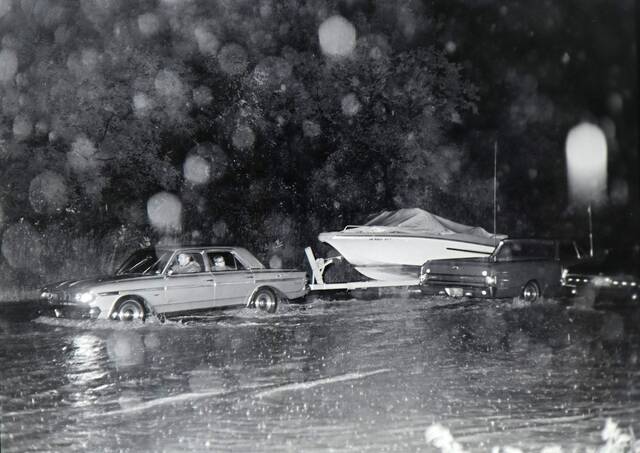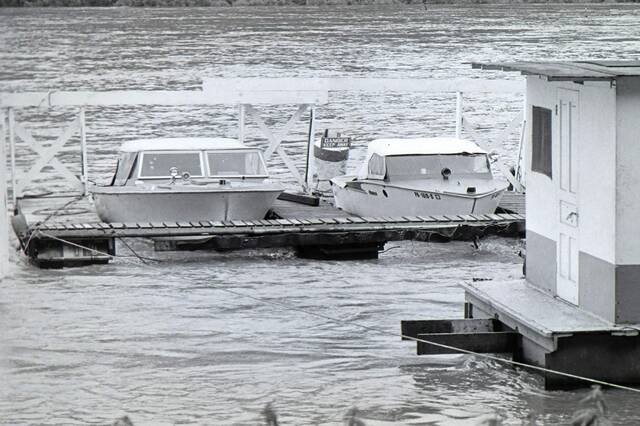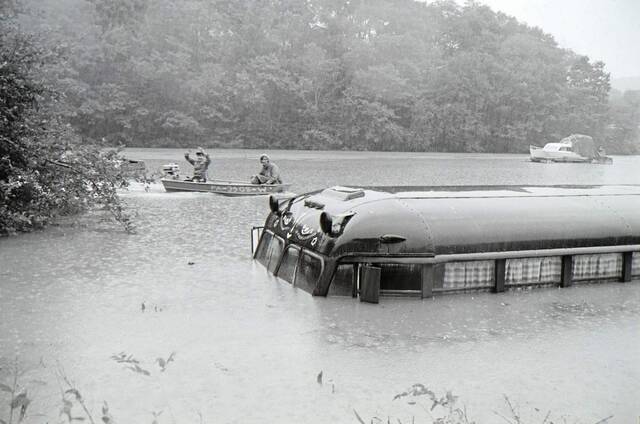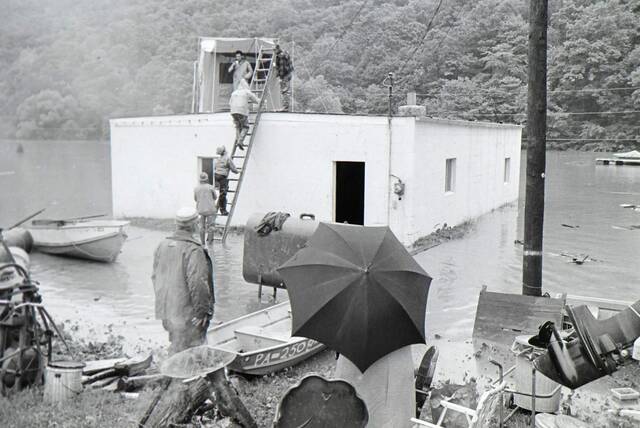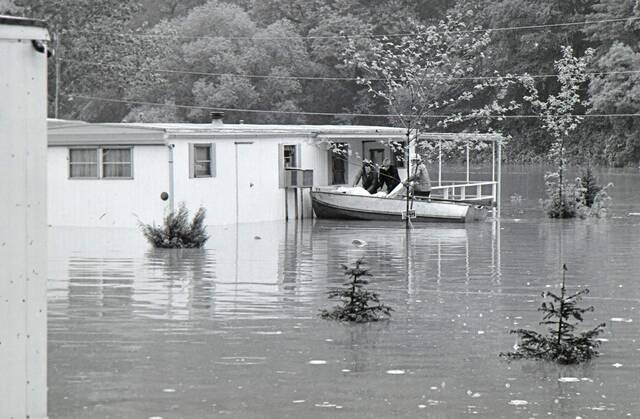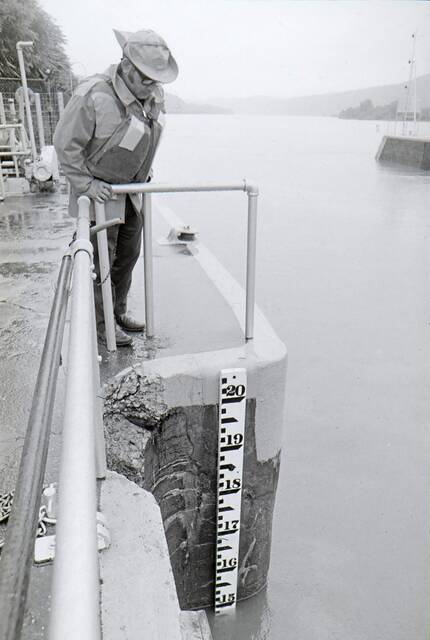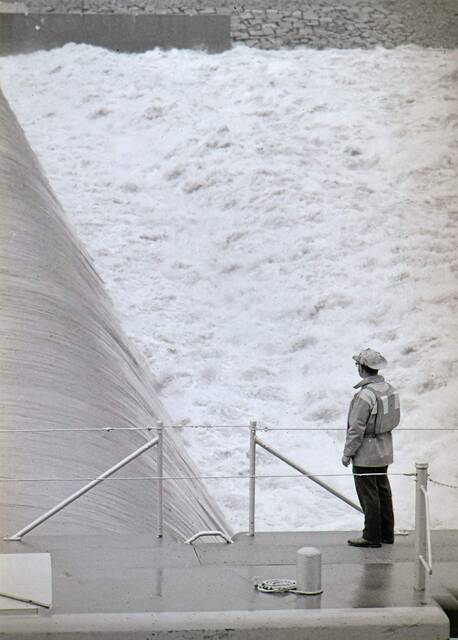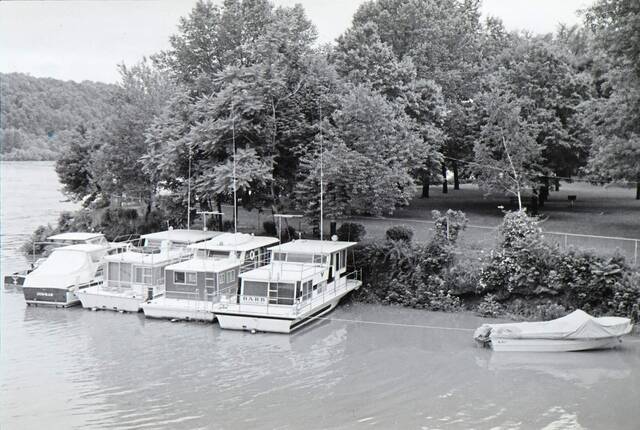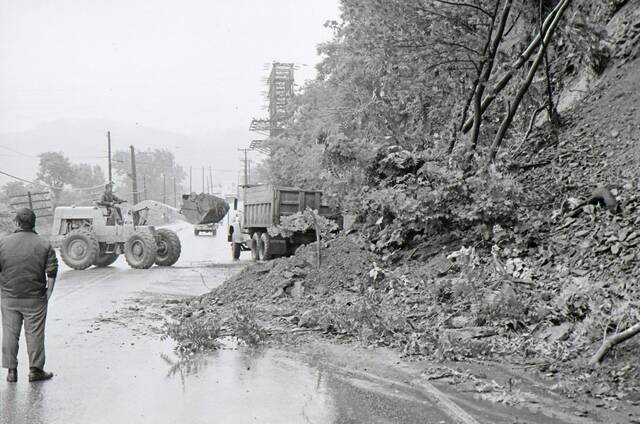50 years ago, Hurricane Agnes left indelible mark
Floods came with living in Freeport.
“You just knew it was inevitable,” said Jim Scott, who grew up in a house on First Street with Buffalo Creek at one end and the Allegheny River at the other. “If you lived there, you took the chance of having to deal with it. If it came, you dealt with it. If you got lucky and it didn’t occur, you moved on until the next year.”
Fifty years ago, in mid- to late June 1972, Freeport was the Alle-Kiski Valley community hit hardest by flooding brought by what had been Hurricane Agnes, which a 1973 federal report called “the greatest natural disaster ever to befall this nation.”
“Freeport was in a unique position in that we have the Buffalo Creek also flowing into the river there,” borough native Paul White said. “We had double flooding from the Buffalo Creek and the Allegheny River. All that water coming down from the Buffalo Creek watershed had nowhere to go.”
Scott, 68, left Freeport in 1975 and has been a funeral director in Erie for 45 years. When they sold his mother’s house a little over two years ago after her death, he found a newspaper picture taped onto a photo album.
In the black-and-white image, Scott, then 18, is pulling a boat down a flooded First Street, his home in the background and water up to about his knees. White, then 19, is standing in the boat. He and two others in it — Jim Swartz Jr. and Dennis Huth — were members of the Freeport Volunteer Fire Department. Also with them is Bob Brant, who died in December.
“Back then, neighbors were like family,” Scott said. “We knew everybody, and everybody knew us. It was a small town. We were just there to help. We did it every year.”
Agnes was different.
“The water was probably an inch away from coming into the first floor of the home,” Scott said. “Hurricane Agnes, that was a beast that year. That was a tough one.”
But without the reservoir system built after the St. Patrick’s Day flood of 1936, it would have been much worse.
A storm with two lives
Agnes was a storm with two lives, said Jack Beven, a senior hurricane specialist at the National Hurricane Center in Miami.
Its first was as a typical early-season hurricane. The second was after it combined with another weather system over the eastern U.S., producing heavy rain and flooding on a scale that had not been seen since the 1936 floods in Pennsylvania and the Hurricane Camille floods in Virginia in 1969.
“It was the right combination of ingredients that produced all this devastating rainfall, particularly in Pennsylvania,” Beven said.
Agnes was the first hurricane of the 1972 season, which Beven said had only four named storms. In recent years, there has been on average 15 to 20 Atlantic hurricanes each season, and 2020 was the busiest on record with 30 named storms.
Agnes was first noticed as a tropical depression June 14 over the Yucatan Peninsula. It became a hurricane over the Caribbean four days later and made landfall in the U.S. on June 19 east of the Panama City, Fla., area, Beven said.
“For one full week thereafter, the Eastern Seaboard was under the continuous assault of torrential rains and floods and flash floods which became progressively worse as the week passed,” reads the Natural Disaster Survey Report on Agnes from February 1973.
“Hardly a river basin north of Georgia and east of the Appalachians as far north as New York State was unaffected.
“The storm is unique in the annals of natural disasters in the United States, in that it caused disastrous floods and flash floods almost simultaneously over such a large area.”
Agnes dumped large amounts of rain on western Cuba and spawned tornadoes over the Florida peninsula and Keys, but its sustained winds were never more than minimal hurricane strength.
When it crossed the Florida coast, Agnes degenerated to a tropical storm and was a tropical depression when it turned to Georgia on June 20, according to the report. On June 21, the storm regenerated as it moved out over the Atlantic next to the Carolinas.
It moved north along the coast to New York City on June 22, producing record rains along the way. North of the city, Agnes joined with a large-scale circulation of colder air, and the combined system turned westward over Pennsylvania and western New York, releasing rains totaling 19 inches in some areas.
Rivers and streams from the Carolinas to New York rose to record or near-record stages.
According to the report, $3.5 billion in property damage was caused by floods and flash floods, and 118 people were killed in the U.S.
In Pennsylvania, the heaviest rain fell across the eastern parts of the state. There was heavy flooding and damage along the full length of the Susquehanna River in the state.
Another area of heavy rain extended from New York southwest to the Pittsburgh area, where 7 to 10 inches fell, Beven said.
“Pennsylvania far and away had the worst of the rain and damage from Hurricane Agnes,” Beven said. “That includes Florida, where it made landfall.”
Because of its severity, the name Agnes was retired later in 1972. While surpassed by other hurricanes since, Agnes remains among the top 20 most-damaging hurricanes in U.S. history, mainly from flood damage in the mid-Atlantic and Northeast, Beven said.
Newspapers chronicle damage
Reports over several days in the Valley News Dispatch and Tribune-Review, then separate newspapers, detailed the damage Agnes wrought on the Alle-Kiski Valley and Westmoreland County.
The ground already was saturated by weeklong rain. The rain interfered with the American Wind Symphony, which was performing on a barge at Tarentum’s Riverview Memorial Park.
After being rained out June 20, the symphony played four songs in more rain the next night for a crowd of 300 that included a CBS crew filming the concert for Charles Kuralt’s “On the Road” segment.
What was an inconvenience soon became a disaster.
By the end of the week, hundreds of Allegheny Valley residents had been evacuated from homes in several communities as floodwaters from the river and its tributaries filled basements and reached first floors.
Streams and creeks flooded their banks in central and southern Westmoreland County. Residents in low-lying areas of Latrobe, Derry, Unity and Trafford fled their homes, some finding shelter in schools, as countless cellars filled with water. Heavy flooding also was reported in Youngwood and New Stanton.
The most significant damage was reported in Derry, where a small dam broke, and Unity, where a bridge was washed out.
Amy Washington was 6 years old then and remembers her family leaving their home by a creek in Irwin for higher ground.
“It flooded very badly. I saw high school kids going down the road in rafts,” said Washington, who now lives in Scottdale. “It’s one of those memories that sticks with you, being so young. I don’t like water.”
Firefighters were sandbagging against rising waters in the lower areas of Latrobe. Former Derry fire Chief Vincent Cackowski Jr. was among them, 20 years old and new to the department.
“I was working at a machine shop. I couldn’t get to work. The roads going to the shop were flooded,” he said.
Flooding and landslides blocked roads and knocked out electricity and telephone service throughout the region.
Along Freeport Road in East Deer, a mudslide pushed a vacant house off its foundation.
Homes were partially underwater in the Godfrey section of Gilpin and surrounded by water in the River Forest area of Allegheny Township.
Julia Strzesieski, then 11, remembers her older cousins helping her dad move furniture to the second floor of their house along the river in the Karns area of Harrison while she, her mother and siblings went to her grandmother’s house in Natrona.
“My dad had a shotgun in case he needed to fire a shot into the air to alert authorities that they needed help,” she said.
Her mother, Helen Strzesieski, said their neighbors with summer homes came down.
“The neighbors all watched together while the river kept rising and rising,” she said. “The river crested and was several feet into our cellar — didn’t get to the furnace, fortunately, but a few more feet it would have been inside our first floor.”
More than 100 boats were reported to have been washed down the Allegheny and over the Highland Park dam. In a photo, Mike Hilovsky, who moored his boat above Allegheny Street in Tarentum, is seen pulling it to safety early on June 23. Hilovsky, who owned the Praha Hotel in Tarentum for 45 years, died in 2006.
Several hundred brandy barrels were swept from the grounds of the Joseph S. Finch Co. distillery in the Schenley area of Gilpin and sent down the Allegheny toward Pittsburgh.
Mike Werries of Springdale was working as a summer laborer at the power plant there that year to earn money for college. He was working overtime that weekend to keep debris clear from the screens that filtered water going into the plant.
“Most of the Valley didn’t know how close the power station came to being shut down because of the swollen river,” he said.
He saw some of the plant’s workers fish the barrels from the distillery out of the river to take home.
Freeport takes heaviest blow
While the flooding Allegheny River forced families in many communities to flee, Freeport was hit the hardest.
Residents on First, Second, High and Market streets and Riverside Drive evacuated, some in rowboats, as water covered the streets and flowed into the first floors of homes. A trailer court in the Laneville section was swamped.
Denise Golembiesky Tannler, 64, remembers water getting within two steps of the first floor of her home on Riverside Drive. Her parents sent her to her aunt and uncle’s home.
“They were staying to try to keep the water from coming up on the first floor,” she said. “I don’t think he had any control of that. You can’t mop it up as it’s coming up.”
As seen in the photo, Scott said he and the others were pulling the boat around, evacuating people from First Street.
“People back then, they were not willing to give up their homes. They would stay in there until it got really bad,” he said. “Then they would finally make the decision to vacate.”
Swartz, 69 and today the president of Freeport’s fire department, was 19 and had been a member of the department since January 1971. He was on borough council for 25 years before becoming mayor in 2009, an office he resigned from this month.
Swartz remembered one man, predicting what was coming, had tied a boat to his house.
“The water really came up,” he said. “You couldn’t even get into town, unless you came from South Buffalo.”
Seeing the picture jogged White’s memory. He left the area in 1984 and has lived in Sarasota, Fla., since 1996.
“We were helping residents with moving their belongings to higher points in their houses and assisting in any way that we could,” he said.
As the waters receded, a flood of sightseers became the problem. Traffic from unwanted observers became so extensive that entrances to the borough were closed.
Communities along the Kiski River escaped serious damage. With the river kept within its banks in most places by the Conemaugh River and Loyalhanna lakes, only minor flooding was reported in low-lying areas of Leechburg and Banfield.
Reservoir system reduces damage
The Conemaugh River and Loyalhanna lakes are two of 16 flood damage reduction projects in the U.S. Army Corps of Engineers Pittsburgh District. They and several others were authorized by the flood control acts of 1936 and 1938, following the St. Patrick’s Day flood of March 1936 that devastated Pittsburgh and communities along the Allegheny and Kiski rivers.
The reservoirs in the Allegheny and Kiski watersheds did what they were built to do when Agnes came, said Werner Loehlein of West Deer, who was chief of water management when he retired from the Corps of Engineers in 2016.
Without the reservoirs, flooding from Agnes would have been worse than 1936, he said.
“The story of Hurricane Agnes is really a testimony to the result of the St. Patrick’s Day flood of March 18, 1936, and the amount of flood damages prevented,” he said. “We can thank our grandparents for that.”
Eight in the Allegheny and Kiski watersheds — Conemaugh, Crooked Creek Lake, East Branch Clarion River Lake, Kinzua Dam and Allegheny Reservoir, Loyalhanna Lake, Mahoning Creek Lake, Tionesta Lake and Union City Dam — were operating in 1972. Construction had just started on the ninth, Woodcock Creek Lake near Meadville.
At the point in Pittsburgh, the river is normally around 16 to 16.5 feet, Loehlein said. In 1936, it crested at 46 feet.
The reservoir system was designed to handle a recurrence of that 1936 event, Loehlein said. When Agnes hit, the Allegheny River reached the 25-foot flood stage on June 23 and crested at 35.8 feet on June 24. The crest was 11 feet above flood stage but 10 feet less than in 1936.
Without the reservoirs, Loehlein said the crest would have been up to 48 feet, two feet higher than in 1936.
The Allegheny Reservoir, controlling about 20% of the Allegheny watershed, filled almost to capacity and by itself reduced the crest in Pittsburgh by four feet, Loehlein said.
Conemaugh and Loyalhanna combined control for 84% of the Kiski watershed, with Conemaugh accounting for most of it, Loehlein said. In 1972, Conemaugh was reported to have reached 88% of its capacity.
In 1936, Apollo, North Vandergrift, East Vandergrift and Leechburg all sustained heavy damages; with the dam in place, only scattered basement flooding was reported.
“Every single one worked as designed,” Loehlein said. “They have paid for themselves multiple times over in flood damages prevented.”
Brian C. Rittmeyer is a TribLive reporter covering news in New Kensington, Arnold and Plum. A Pittsburgh native and graduate of Penn State University's Schreyer Honors College, Brian has been with the Trib since December 2000. He can be reached at brittmeyer@triblive.com.
Remove the ads from your TribLIVE reading experience but still support the journalists who create the content with TribLIVE Ad-Free.



